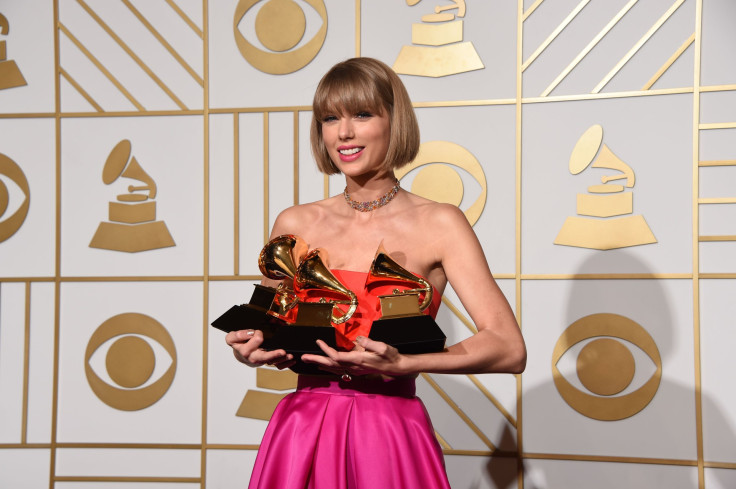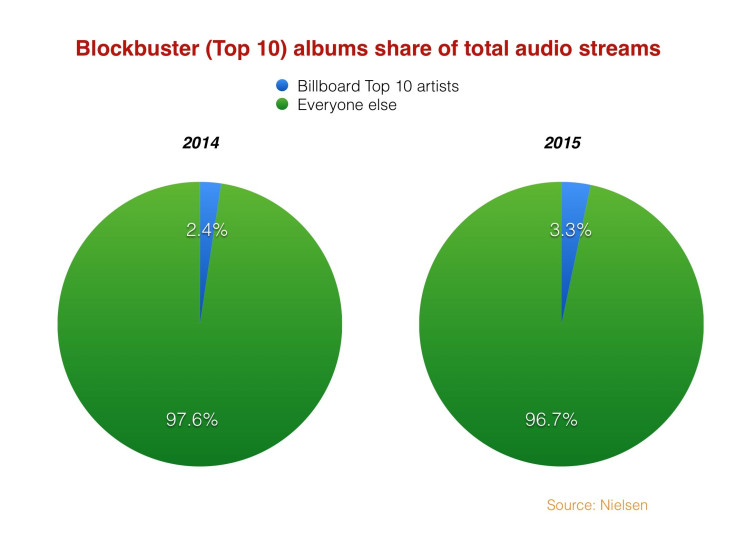How Streaming Music Services Favor The Top 1% Of Megastars Like Justin Bieber, The Weeknd, Drake And Taylor Swift

The great promise of music streaming services like Spotify or Apple Music is unlimited access to any song or album, anytime on any device. It's supposed to free listeners from the strictures of radio playlists, or record store shelf space, and give them the freedom to try something new.
Yet new statistics suggest that the exact opposite is happening.
The overall share of on-demand streams that flowed to recent albums made by the top 10 best-selling artists grew 38 percent in 2015, to an all-time high of 3.3 percent. That top 10 list, which is comprised almost entirely of global megastars like Justin Bieber, sucked up more than 4.7 billion streams last year, two and a half times the 1.8 billion drawn by a similar list of artists in 2014, and that enormous share only accounts for the songs streamed from those stars' most recent albums. It does not count any of the millions of streams generated by those artists' back catalogs.
This shift was first spotted by Music Business Worldwide.

The truth is the future of streaming music is more like Top 40 radio than anyone would care to admit.
That's partly explained by the fact that an on-demand streaming service removes any barrier to trying an album. If everyone in your life is chatting about the new Weeknd album, it takes barely any effort to try it out for yourself.
It can also be explained, to a degree, by the growth of streaming in general. Nielsen tallied nearly 145 billion on-demand music streams in 2015, nearly double the 79 billion it counted up the previous year, and the rising tide has lifted all boats, though to varying degrees. A full 25 percent of independent labels earn at least half their digital income from streaming now, according to a member poll conducted by digital rights agency Merlin last year. And recent earnings reports showed that Universal Music Group, the world’s largest record company, posted its largest annual revenue total in 10 years in 2015, thanks largely to its streaming income, which leaped 43 percent to $1.04 billion.
UMG owes a lot of that success to the fact that it represents or distributes most of the artists on this year’s list, including Justin Bieber, the Weeknd, Drake, Sam Smith and Taylor Swift, an independent artist who uses UMG to distribute her music.
While all of the on-demand streaming services are investing significant resources to make it easier for fans to discover new music, the reality is that streaming continues to disproportionately benefit artists who are already well-known. Top-tier artists earned 77 percent of the money generated through on-demand streaming back in 2014, according to an analysis conducted by MIDiA Research.
That disparity will be even more pronounced this year, and it could have been even wider if two of the artists on this year’s top 10 list, Adele and Taylor Swift, weren't so ambivalent about streaming services. Both women have only put select portions of their catalog on these services — Taylor Swift has famously kept her entire catalog off Spotify, the world’s largest on-demand streaming service, and last year Adele made just one song from her chart-crushing third album, “25,” available on them. That song, “Hello,” was streamed more times than all of the combined songs on three of the top-streamed albums from last year.
As streaming eventually becomes the dominant mode of music consumption, it's possible that listener behavior will begin to change. Spotify, for example, drove more than 1 billion streams of up-and-coming artists through its Discover Weekly feature last year.
Until then, think of streaming as a version of Top 40 radio, only worse. On the radio, data picks what you listen to; online, users do the choosing. But for now, statistics like these show that unlimited access is only benefiting those at the top.
© Copyright IBTimes 2024. All rights reserved.











